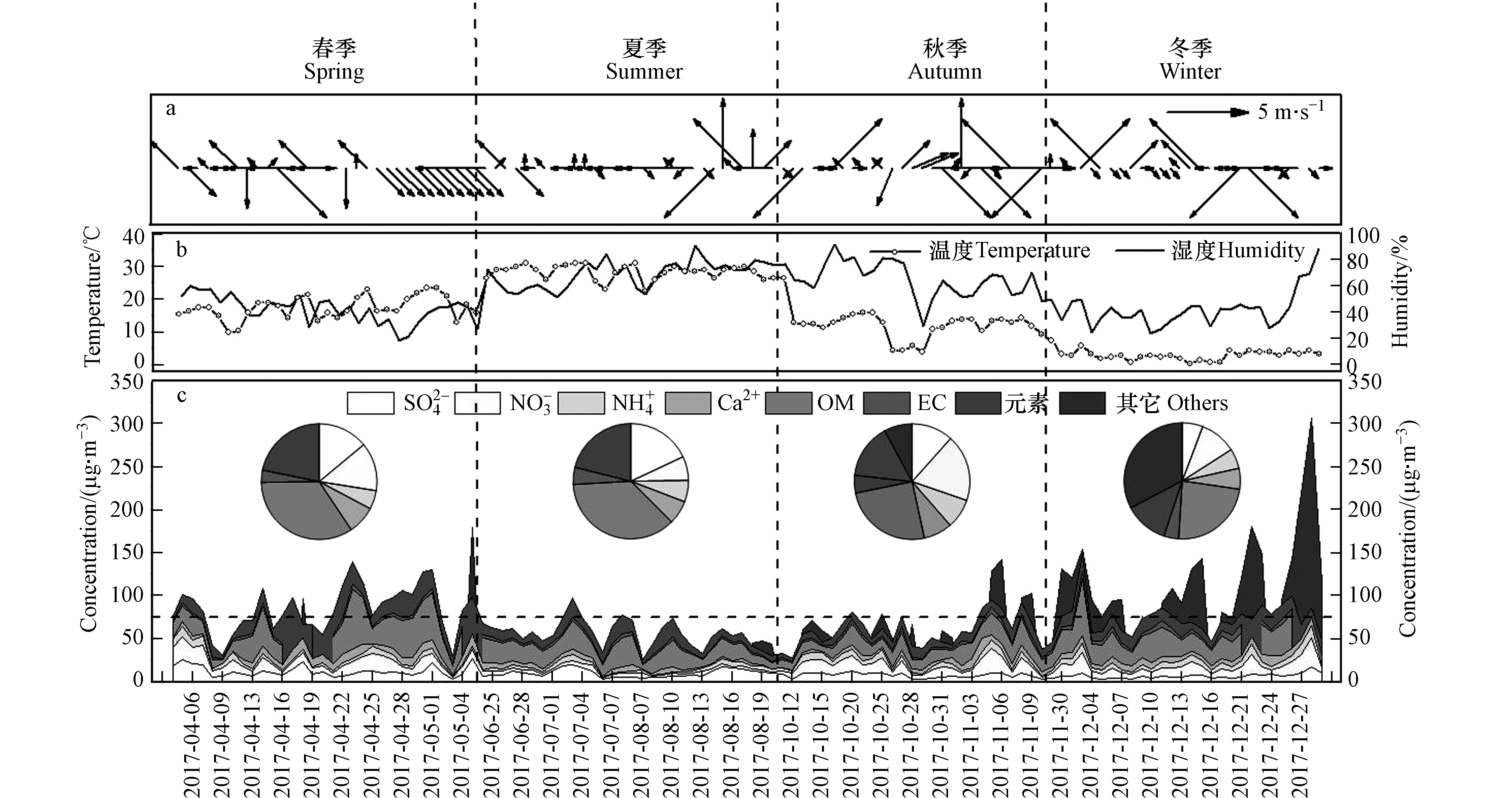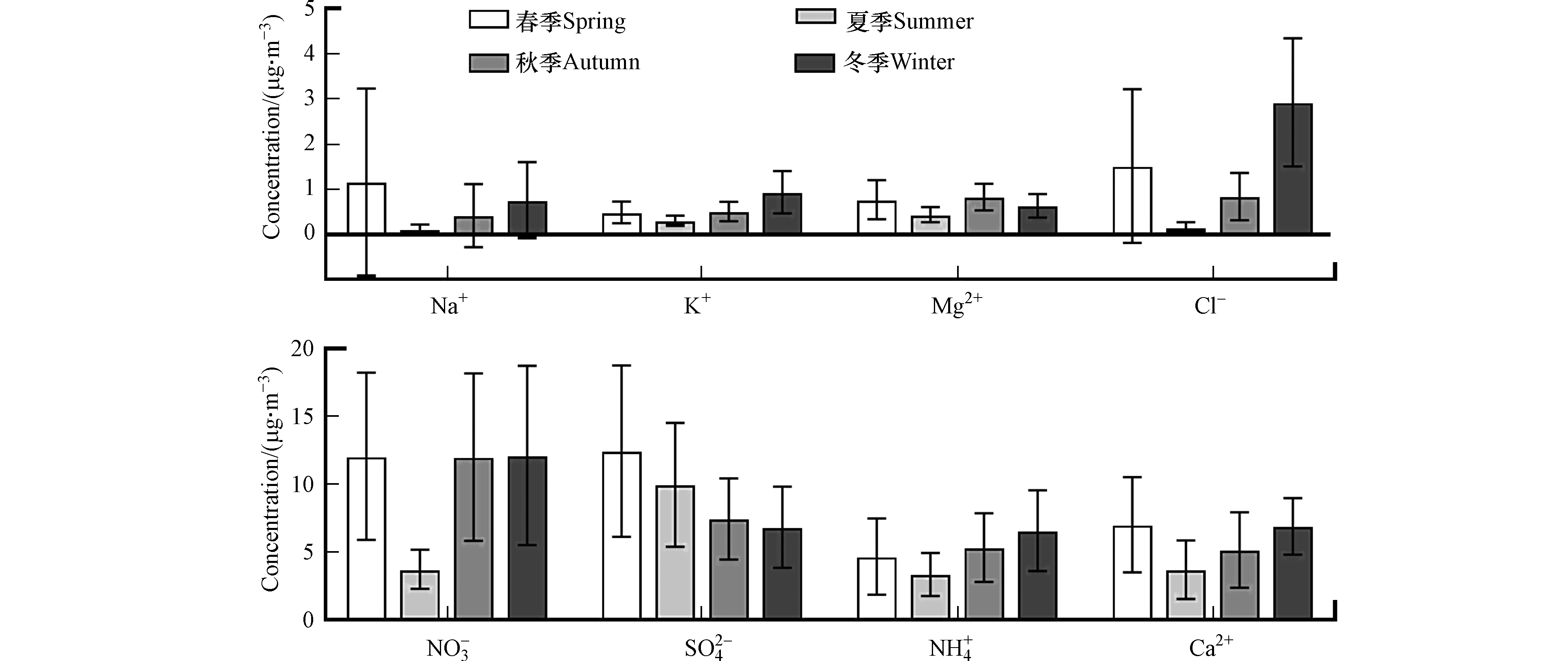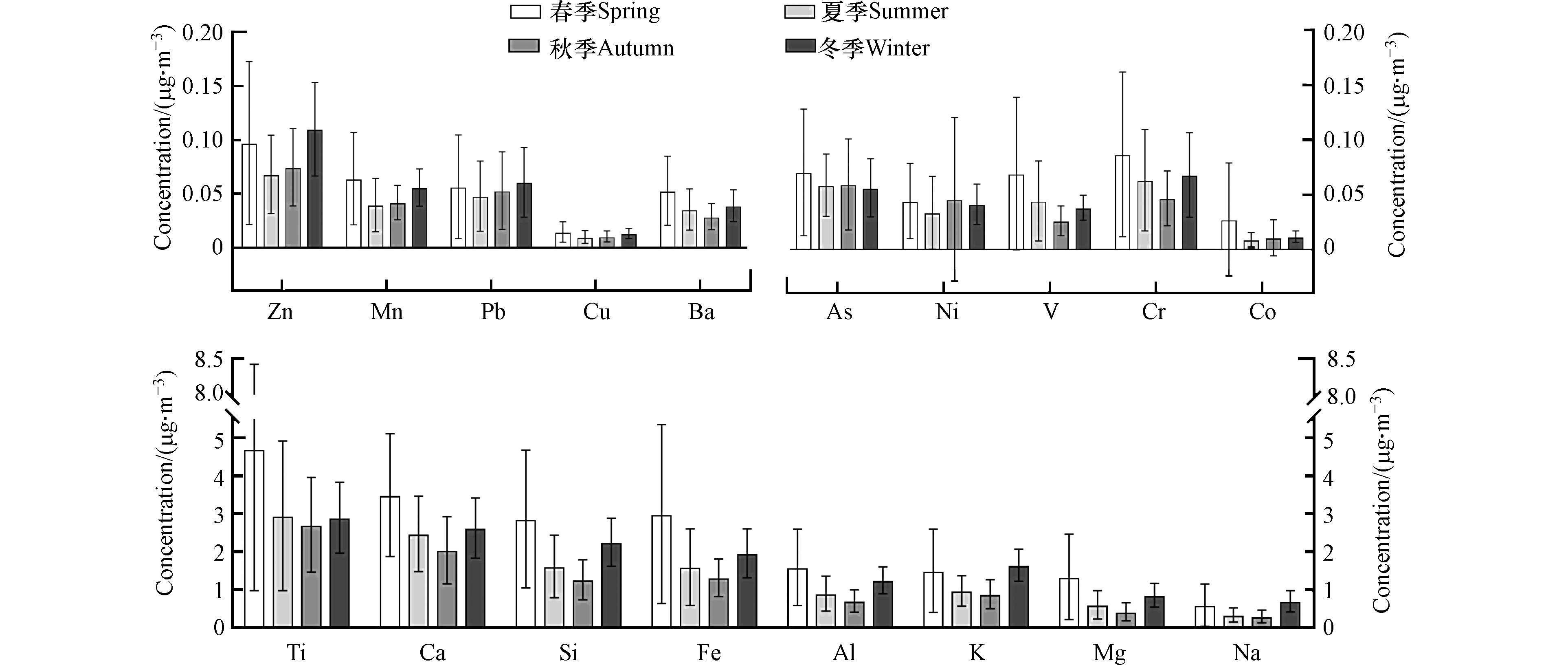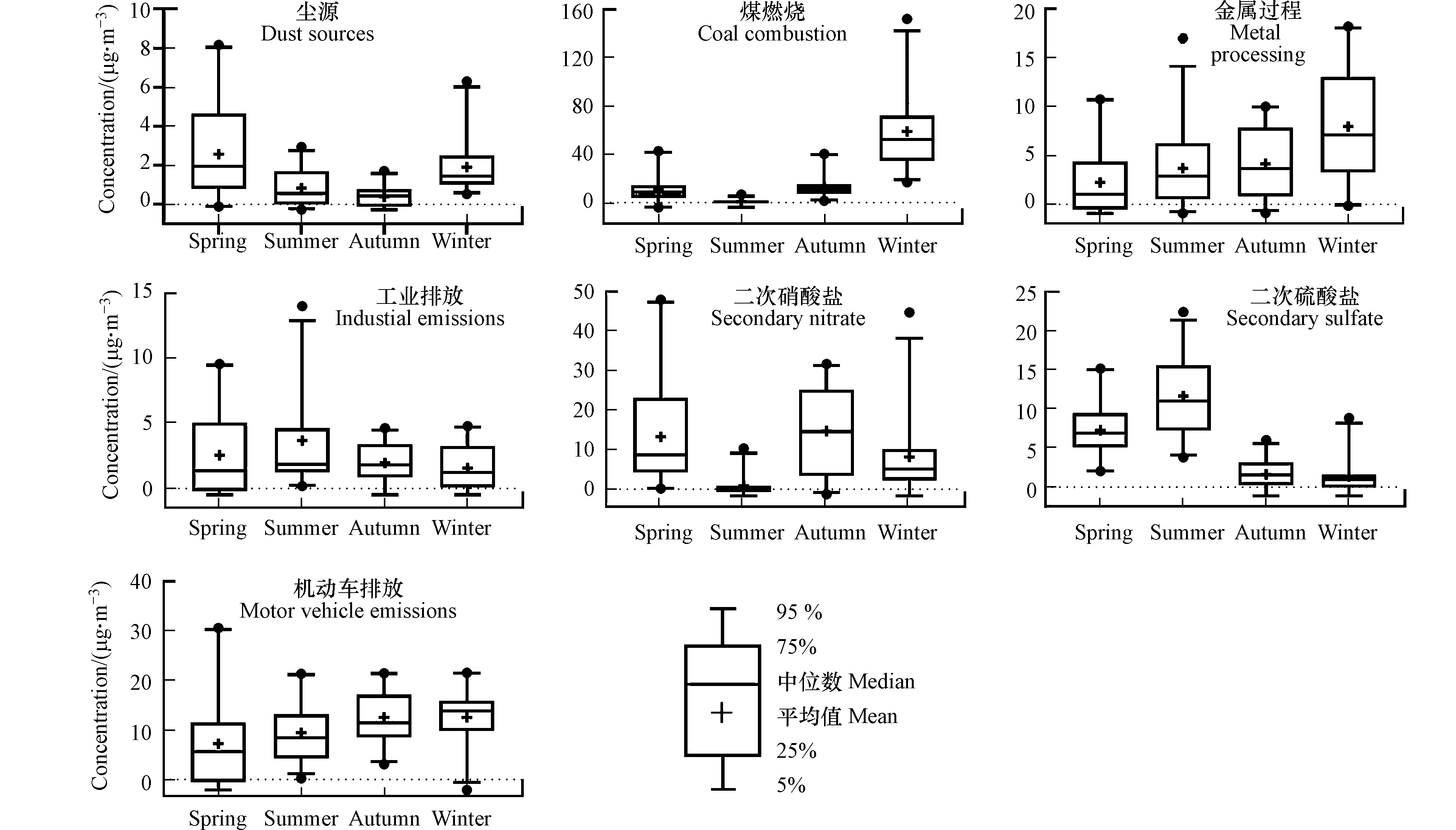-
大气细颗粒物(PM2.5)是大气中的重要污染物,不仅对大气环境质量[1-2]有显著影响,而且与人体健康[3-4]以及全球气候变化[5]有着紧密的联系。PM2.5可通过呼吸系统进入肺部,引起如哮喘,咳嗽等健康问题[6],甚至引发肺癌等病症导致死亡[7-9]。大气PM2.5可通过吸收和散射太阳辐射直接影响气候,也可通过云凝结核的形式改变云的光学性质和分布而间接影响气候[10],还可影响城市大气能见度[11]。另外,大气PM2.5可在大气环境中长时间停留产生二次污染,使其可水平输送到其它地区而影响区域大气环境[12-13]。
大气PM2.5是来自天然和人为污染的复杂混合物,包括一次排放和二次形成颗粒物,其化学成分复杂,主要包括水溶性离子、有机碳(OC)、元素碳(EC)和无机元素[14]。水溶性离子约占大气PM2.5的33%—61%[15],其中,二次离子
${\rm{NH}}_4^{+} $ 、${\rm{SO}}_4^{2-} $ 和${\rm{NO}}_3^{-} $ 一般是由大气中的SO2、NOx和NH3经过二次化学反应生成,主要来自机动车尾气及燃煤排放[16]。OC和EC约占PM2.5的20%—60%[17],EC主要来源于燃料不完全燃烧,如机动车排放、烹饪、森林大火等[18];OC的形成过程和来源可分为污染源直接排放的一次有机碳和有机气体经光化学反应等途径生成的二次有机碳[19-20]。在严重雾霾污染中二次化学组分可以占到PM2.5的30%—77%[16, 21]。无机元素是大气PM2.5的另一重要成分,可分为地壳元素(如Fe、Al、Ca和Si等)和人为污染元素(如Zn、Pb、Cu、Cr、Ni和Cd等),其中地壳元素对PM2.5的贡献约为20%,人为污染元素通常来自各种工业排放,在PM2.5中占比约1%—2%,对人体健康存在极大危害[22-24]。PM2.5的来源复杂且污染源的相对贡献因区域和时间的变化而变化,为反映其实际变化与及时调整防治政策需要对PM2.5的来源不断更新。目前,国内外已有众多关于PM2.5源解析的研究,例如,孟加拉国的半住宅和城市地区PM2.5的来源主要是机动车排放和生物质燃烧[25];印度海得拉巴交通走廊的PM2.5主要来自车辆排放和重悬浮粉尘[26]。京津冀地区PM2.5的主要来源是燃煤、交通、扬尘以及二次气溶胶,且近年来从燃煤主导的煤烟型污染转变为燃煤[27-28]和机动车复合型污染[21, 29]。西安市地区的污染主要受燃煤、机动车排放及二次污染影响[30],且冬季燃煤供暖会加剧西安当地的空气污染,如对西安冬季严重雾霾时期的PM2.5来源研究发现粉尘相关来源(如道路尘、建筑扬尘和沙尘暴)对PM2.5的贡献达到46%[21]。
西安是中国西北的重要工业城市,位于关中平原的中心,是中国污染最严重的地区之一[31],及时对西安大气PM2.5的化学组分及其来源进行研究至关重要。因此,本研究采集西安市2017年全年大气PM2.5样品,分析其化学组分,采用正矩阵因子分析(PMF)模型解析其污染源,结合气象条件探究影响西安市大气PM2.5的化学组分及其来源的主要因素。通过研究西安市大气环境污染源变化特征,对了解大气PM2.5的健康效应及制定环境污染控制措施提供理论支撑,并对后续的大气PM2.5的研究具有重要的参考意义。
全文HTML
-
采样点位于陕西科技大学逸夫楼大楼顶(N 34°22′35.07″,E 108°58′34.58″,地面高度约30 m),利用XT-1025型智能大流量PM2.5采样器(1 m3·min−1,中国上海新拓分析仪器技术有限公司)采集2017-04-04 — 2017-12-29的日样品共计121个(含空白5个),其中春季(4月4日—5月5日)、夏季(6月24日— 7月9日、8月7—21日)、秋季(10月12日—11月11日) 和冬季(11月30—12月29日) 分别采集有效样品31、31、27、27个,具体时间为每天早上07: 00—次日06:30,采样时长为23 h 30 min。采样介质为提前用450 ℃马弗炉烤焙6 h的石英滤膜(PALLLifeScience,TISSUQUARTZ 2500QAT-UP),收集好的PM2.5样品用锡纸包裹并放入铝箔袋中于−20 ℃的冰箱中保存直至分析。
-
有机碳(OC)和元素碳(EC)是利用Model-4型半连续OC/EC分析仪(Sunset Lab.)通过热光学透射率法进行测量并定量[31]。水溶性阴阳离子(Cl−、
${\rm{NO}}_3^{-} $ 、${\rm{SO}}_4^{2-} $ 、Na+、${\rm{NH}}_4^{+} $ 、K+、Mg2+和Ca2+)是超声提取并用离子色谱(940 Professional IC Vario,Metrohm)进行测定[32],步骤简单如下:裁取3张直径为12 mm的滤膜样品放在50 mL的离心管,加入15 mL超纯水并超声30 min,上清液经0.45 μm滤膜过滤后上机测试。元素组分包括Si、Na、Al、K、Ti、V、Ni、Cu、Zn、As等18种,分两步进行测定。首先,从每个样品裁取直径为5 mm的滤膜,利用激光烧蚀电感耦合等离子体质谱仪(LA-ICP-MS)进行测量[33]。每一轮测量时随机抽取一个样品作为标准样品,以获得每个滤膜的相对信号强度(RSI)。其次,用5 mL超纯水、2 mL硝酸(Optima grade,Fisher Scientific)和1 mL过氧化氢(Optima grade,Fisher Scientific)将标准石英滤膜样品上的气溶胶颗粒溶解在特氟龙管中用于微波消解,再用ICP-MS(Thermo Scientific)定量分析[34]。最后,对LA-ICP-MS和ICP-MS获得的RSI进行分析计算,从而得到各样品中的元素浓度[35]。 -
采样期间的PM2.5浓度数据主要从中国环境监测网站(http://www.zghjjcw.com/)收集;温度、相对湿度、风速、风向等气象参数主要从Weather Underground(https://www.wunderground.com/weather/cn/xi’an)获得。
-
本研究采用美国环境保护局(EPA)的正矩阵因子分解(PMF 5.0)模型对西安市大气PM2.5的来源进行解析。本研究将PM2.5、OC、EC、Cl−、
${\rm{NO}}_3^{-} $ 、${\rm{SO}}_4^{2-} $ 、Na+、${\rm{NH}}_4^{+} $ 、K+、Mg2+、Ca2+、Ti、Ca、Si、K、Fe、Al、Mg、Na、Pb、Zn、Mn、Ba、Cu、As、Ni、V、Cr、Cd的浓度数据输入EPA PMF 5.0模型中,经过模型多次运转分析,最终获得影响西安大气PM2.5的7个主要来源:煤燃烧(31%)、机动车排放(16%)、二次硝酸盐(13%)、二次硫酸盐(9%)、金属过程(7%)、工业排放(4%)、尘源(2%),可解释(92%±27%)的PM2.5来源,因子识别等具体细节参考Wang等的文章[35]。解析过程中,将组分浓度的缺失值用该组分浓度中位值替代,其不确定度为4倍的中位数,以降低组分浓度缺失值对模型的影响;将低于方法检测限(MDL)的组分浓度替换为MDL的一半,并利用公式(1)[36]确定各组分的不确定度。其中,Unc.为不确定度;Conc.为组分浓度;K为分析不确定度,PM2.5、离子、OC、EC、WSOC、WISOC的K为5%,元素组分的K为10%。
1.1. 样品采集
1.2. 样品分析
1.3. PM2.5浓度和气象数据
1.4. PMF来源解析
-
大气颗粒物质量闭合可以通过不同成分化合物在大气颗粒物中的占比来估计不同来源气溶胶对环境空气质量的影响[30]。按OM(OC×1.8[37])、EC、元素和(所测所有元素的浓度之和)以及水溶性离子中的
${\rm{NH}}_4^{+} $ 、Ca2+、${\rm{NO}}_3^{-} $ 和${\rm{SO}}_4^{2-} $ 对PM2.5进行质量重组,如图1和图2c所示。西安市PM2.5年平均浓度为(64±45 )μg·m−3,范围15—307 μg·m−3,冬季最高,其次为秋季、春季和夏季,原因可能是西安市冬季大规模燃烧煤炭取暖而排放出大量污染物。OM、${\rm{SO}}_4^{2-} $ 、${\rm{NO}}_3^{-} $ 及元素在全年对PM2.5的贡献较高,分别为33%、13%、14%和20%;SO42-和${\rm{NO}}_3^{-} $ 在春季对PM2.5的贡献几乎相同,约为14%,夏季${\rm{SO}}_4^{2-} $ 贡献是${\rm{NO}}_3^{-} $ 贡献的2.67倍,秋冬两季${\rm{NO}}_3^{-} $ 贡献明显高于${\rm{SO}}_4^{2-} $ ,主要与燃料燃烧以及机动车排放有关。无机元素对PM2.5贡献随着季节变化呈缓慢递减趋势;OM春夏季对PM2.5的贡献明显高于秋冬季;${\rm{NH}}_4^{+} $ 和EC对PM2.5贡献从春季到秋季呈缓慢递增趋势,冬季有略微减少;除${\rm{NO}}_3^{-} $ 外,这些组分对PM2.5的最低贡献均出现在冬季,更多贡献来源于其它组分,表明西安市冬季污染源更为复杂。Ca2+对PM2.5的年均贡献为8%且各季节都较稳定,明显高于2014 — 2015年西安市的Ca+对PM2.5的贡献(2%)[38],表明道路尘、土壤尘和建筑施工扬尘等对西安市的大气PM2.5的影响日益增加。从图2c可看出,各化学组分在不同季节对PM2.5的贡献有所差异,说明西安市大气PM2.5各个季节的污染来源不同,影响其化学组成成分的因素也不同。 -
本研究中,
${\rm{NH}}_4^{+} $ 、${\rm{SO}}_4^{2-} $ 、${\rm{NO}}_3^{-} $ 和Ca2+是西安市PM2.5中水溶性离子的主要组分,占总离子浓度的89%,并占PM2.5年均浓度的46%。如图3所示,春季Ca2+平均浓度高于冬季、秋季和夏季;春季浓度高与春季易发生扬沙及浮尘天气有关,如2017-04-18和2017-04-19的沙尘事件可能会造成Ca2+及其他化学组分的春季平均浓度升高。Cl−和K+的浓度变化与本溪市[39]的趋势一致,均为冬季最高,夏季最低。两个城市都属于综合性工业城市,影响Cl−和K+的浓度变化的因素可能相同,冬季浓度最高可能与煤燃烧有关[40],而春季可能与风沙较大有关。${\rm{NH}}_4^{+} $ 和${\rm{NO}}_3^{-} $ 均呈现春季高夏季低且夏季至冬季呈递增趋势。${\rm{SO}}_4^{2-} $ 从春季到冬季呈递减趋势,春季最高可能源自春季沙尘携带大量硫酸盐[41],夏季由于高温(如图2b)与强光照不利于二次${\rm{NO}}_3^{-} $ 与${\rm{NH}}_4^{+} $ 的生成但有利于二次${\rm{SO}}_4^{2-} $ 的生成。王念飞等[42]研究发现${\rm{NO}}_3^{-} $ 平均浓度高于${\rm{SO}}_4^{2-} $ ,与本研究的结果相符,原因可能是机动车保有量的日益增加及政府近年来一系列的节能减排措施的执行。[${\rm{NO}}_3^{-} $ ]/[${\rm{SO}}_4^{2-} $ ]的年均值为(1.19±0.68),可能是移动源增加和固定源减少双重作用的结果[43]。[${\rm{NO}}_3^{-} $ ]/[${\rm{SO}}_4^{2-} $ ]比值呈现冬季(1.79±0.50)>秋季(1.62±0.53)>春季(1.04±0.40)>夏季(0.46±0.27)的变化趋势,表明西安市夏季PM2.5主要受固定源影响,其他季节主要受移动源影响。 -
本研究主要分析PM2.5中18种元素浓度的季节变化特征,结果见图4。元素总浓度范围为2.65—60.05 μg·m−3,对PM2.5的贡献为4%—96%,且年均浓度为(13.95±8.17 )μg·m−3,占PM2.5的22%。春冬两季各元素浓度高于夏秋两季,变化规律与PM2.5有所不同,说明西安市在不同季节里PM2.5中无机元素含量不稳定。Ti、Ca、Si、K、Fe、Al、Mg、Na是地壳代表元素[44-45],主要来自土壤和扬尘[46-47]及钢铁等冶金行业[48]的大气排放。Pb、Zn、Cu、As、Ni等与人为污染有关[49],最低浓度多出现在夏季。Zn是人为污染元素中浓度最高的,在不同季节PM2.5中的含量均高于0.1%,可能是由橡胶材质材料磨损和镀锌材料产生[46, 50-51],也可能与垃圾和废物燃烧相关[52]。As、Ni、Cu排放规律差异不大,主要受金属冶炼和工业排放的影响[53-54],Cu的浓度高于As和Ni,可能是机动车排放对Cu贡献较大[55]。Pb是机动车排放的重要标志之一[56-57],然而近年来含Pb汽油的禁用导致大气中Pb的含量降低。目前的研究发现Pb主要源自化石燃料燃烧[58],燃煤中有20%的灰铅,其中1/3的Pb排入大气形成颗粒物[51],本研究中Pb的浓度最高值出现在冬季,主要受冬季煤燃烧影响。
-
有机碳和元素碳的年均质量浓度分别为(13.02±6.69 )μg·m−3和(3.35±1.17 )μg·m−3,其变化特征见图5。EC与PM2.5的变化趋势一致,春、夏、秋季浓度变化不大,表明西安市一次排放较为稳定;冬季最高为(4.88±1.97 )μg·m−3,显著高于其他三季,可能是受机动车尾气排放和集中供暖燃煤排放共同影响。OC的季节变化与EC不同,春季最高为(15.62±5.84)μg·m−3,其次为冬季>夏季>秋季的污染特征。对比西安市2015年供暖期OC(25.7±20.7)μg·m−3与EC(10.8±7.0)μg·m−3浓度[59]发现,2017年OC与EC平均浓度分别下降39%和55%,表明西安市的燃煤控制对减少大气PM2.5排放效果显著。结合OC/EC值发现,年均值(4.05±1.49),波动范围1.51—10.02,显示出西安大气的二次污染现象[60-61]较为突出。秋季OC/EC值最小,仅有(2.97±0.85),说明秋季主要受机动车排放影响;冬季为(3.42±1.00),说明冬季碳气溶胶污染主要由燃煤等燃料燃烧及机动车尾气排放导致[20, 62]。OC和OC/EC的最高均值都在春季出现,春季的主导风向为风速较高的东南风(图2a),说明可能由含碳气溶胶的远距离传输导致。
-
PM2.5源浓度贡献具有显著的季节性特征,如图6所示。春季尘源贡献最高,达到(2.57±2.26)μg·m−3,可能归因于2017年春季的几次沙尘暴事件,如2017-04-18和2017-04-19;冬季煤燃烧贡献最高,达到(58.07±32.50) μg·m−3,说明是由寒冷季节大量燃煤集中供暖导致。工业排放的季节变化不明显,全年波动较为稳定,但仍能看出冬季的平均贡献有所降低,说明西安市的工业水平较为稳定。金属过程呈现全年递增趋势,冬高春低,平均质量浓度范围为(2.23±3.64)—(7.75±5.65) μg·m−3,可能受金属制造业影响。二次硝酸盐的季节变化呈现季节锯齿状,春高夏降秋增冬落,平均质量浓度分别为(13.24±12.86)、(0.84±3.02)、(14.66±10.83)、(8.33±9.95 )μg·m−3;夏季贡献最低可能是夏季高温(如图2b)天气利于颗粒态硝酸盐分解为气态硝酸和氨;二次硫酸盐的季节变化特征呈现夏季最高,春季次之,秋冬两季大幅降低的趋势,夏季最高源于高温高湿(如图2b)的气象条件利于硫酸盐颗粒的产生;二次硫酸盐和硝酸盐冬季贡献较低,说明燃煤锅炉的超低改造以及低温低湿(如图2b)的气象条件共同导致。机动车排放的季节变化特征呈现全年逐渐递增的趋势,但冬季相比秋季增幅较低,平均质量浓度范围为(7.21±9.2)—(12.67±5.39) μg·m−3,表明虽然机动车保有量不断增加,但政府在冬季机动车的限行措施对机动车排放降低有突出贡献。
-
图7为全年不同季节各个源对PM2.5的贡献百分比。春季煤燃烧和二次硝酸盐对PM2.5的贡献达到47%,几乎是其他污染源的贡献总和;二次硫酸盐、机动车排放的贡献亦不可忽视,达到29%。结合气象条件(详见图2a)发现,春季主导风向为风速相对较高的东南风,处于下风向的西安地区可能受污染传输影响。夏季PM2.5主要来自二次硫酸盐和机动车排放,贡献分别达到34%和27%,煤燃烧贡献最低,仅有2%,夏季北风是主导风向,风速2—6 m·s−1。秋季PM2.5的贡献与春季相似,均为二次硝酸盐、煤燃烧贡献较高,机动车排放次之。秋季没有主导风向,表明秋季存在较为复杂的潜在污染源;且4—6 m·s−1的风速有利于污染物的扩散与传输;复杂风向与较高风速相结合导致秋季PM2.5浓度相对较低.
冬季煤燃烧的贡献最高,达到51%;此外,机动车排放贡献11%,其他污染源贡献20%。冬季主导风向为较低风速的东南风,且冬季大气层结稳定,混合层高度相对较低,不利于污染物扩散,说明冬季的污染多是本地污染的排放累积。
2.1. PM2.5时间序列及质量闭合
2.2. 化学组分污染特征
2.2.1. 水溶性阴阳离子
2.2.2. 元素
2.2.3. 有机碳/元素碳
2.3. PM2.5来源解析
2.3.1. 源季节变化特征
2.3.2. 源季节变化的影响因素
-
为研究西安市大气PM2.5污染水平及其来源,本文采集2017年四季共121个大气PM2.5样品,分析其水溶性离子、有机碳、元素碳和元素,并利用正矩阵因子分析解析其来源。通过研究获得以下主要结论:
(1)2017年PM2.5的年均值为(64±45) μg·m−3,范围15—307 μg·m−3;冬季最高,其次为秋季、春季和夏季;OM、
${\rm{SO}}_4^{2-} $ 、${\rm{NO}}_3^{-} $ 及元素对PM2.5的贡献分别为33%、13%、14%和20%;Ca2+对PM2.5的年均贡献为8%,且各季节贡献较为稳定。(2)西安市PM2.5的水溶性离子中
${\rm{SO}}_4^{2-} $ 、${\rm{NO}}_3^{-} $ 、${\rm{NH}}_4^{+} $ 和Ca2+占总水溶性离子的89%,占PM2.5的46%;主要受扬尘、机动车排放、煤燃烧及二次污染影响。(3)西安市PM2.5中总元素年均浓度为(13.95±8.17 )μg·m−3,占PM2.5年均浓度的22%。Pb、Zn、Mn、Ba、Cu、As、Ni、V和Cr等元素主要来自人为排放,如金属冶炼、工业排放、机动车及煤燃烧。
(4)EC冬季浓度最高,达到(4.88±1.97) μg·m−3;OC春季浓度最高,达到(15.62±5.84)μg·m−3;OC/EC的年均值为(4.05±1.49),表明碳气溶胶主要来自燃料燃烧、机动车排放及二次污染。
(5)2017年西安市大气PM2.5主要受煤燃烧、机动车排放、二次硝酸盐和二次硫酸盐影响,同时受气象因素如风速风向影响显著,且冬季污染最为严重。









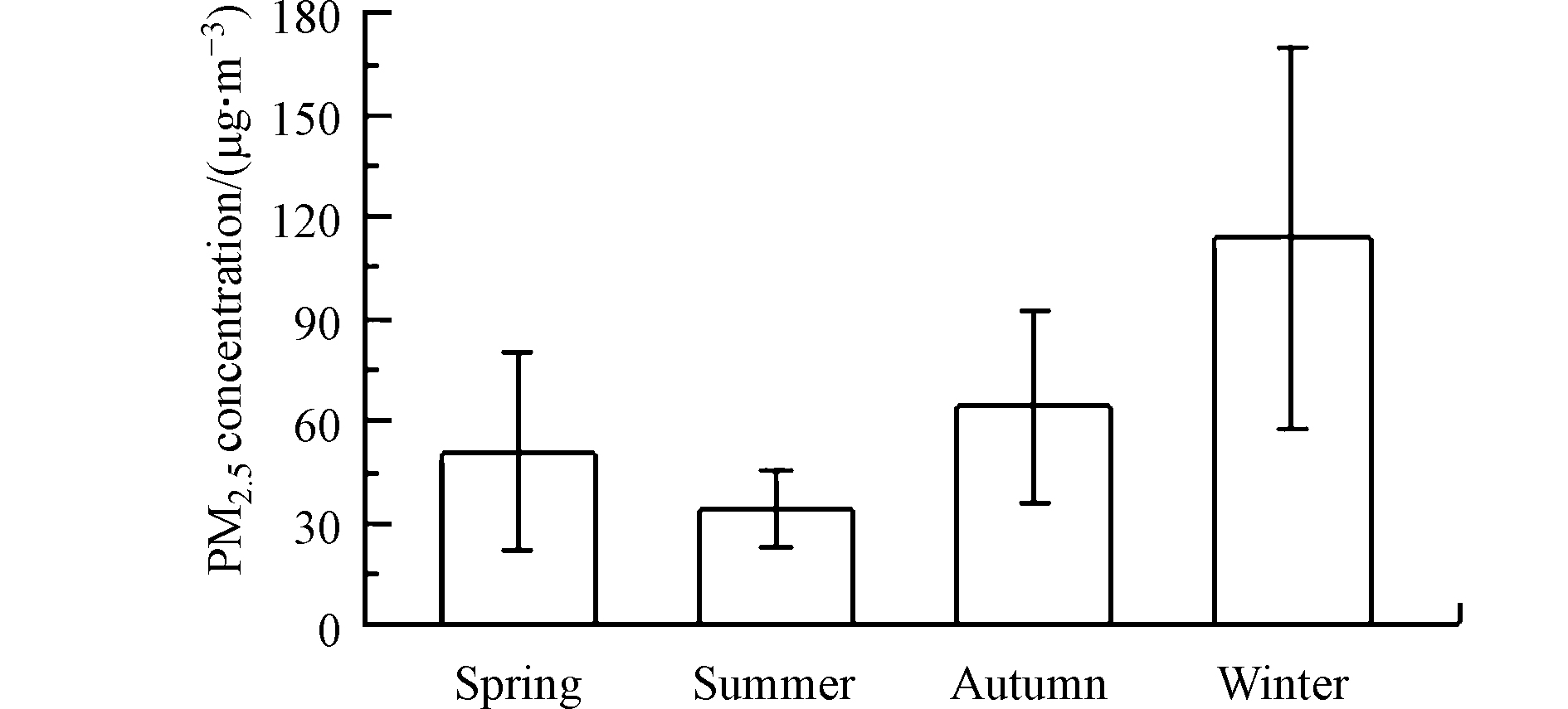
 下载:
下载:
